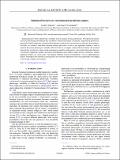Optimized bacteria are environmental prediction engines
Author(s)
Marzen, Sarah E.; Crutchfield, James P.
DownloadPhysRevE.98.012408.pdf (482.2Kb)
PUBLISHER_POLICY
Publisher Policy
Article is made available in accordance with the publisher's policy and may be subject to US copyright law. Please refer to the publisher's site for terms of use.
Terms of use
Metadata
Show full item recordAbstract
Experimentalists observe phenotypic variability even in isogenic bacteria populations. We explore the hypothesis that in fluctuating environments this variability is tuned to maximize a bacterium's expected log-growth rate, potentially aided by epigenetic (all inheritable nongenetic) markers that store information about past environments. Crucially, we assume a time delay between sensing and action, so that a past epigenetic marker is used to generate the present phenotypic variability. We show that, in a complex, memoryful environment, the maximal expected log-growth rate is linear in the instantaneous predictive information—the mutual information between a bacterium's epigenetic markers and future environmental states. Hence, under resource constraints, optimal epigenetic markers are causal states—the minimal sufficient statistics for prediction—or lossy approximations thereof. We propose new theoretical investigations into and new experiments on bacteria phenotypic bet-hedging in fluctuating complex environments.
Date issued
2018-07Department
Massachusetts Institute of Technology. Department of PhysicsJournal
Physical Review E
Publisher
American Physical Society
Citation
Marzen, Sarah E. and Crutchfield, James P. "Optimized bacteria are environmental prediction engines." Physical Review E 98, 1 (July 2018): 012408 © 2018 American Physical Society
Version: Final published version
ISSN
2470-0045
2470-0053